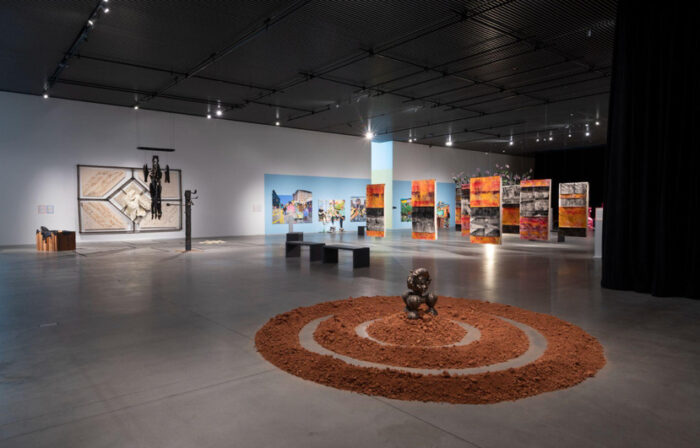
Open Call 2023 Group Exhibition at The Shed
November 4, 2023 – January 21, 2024
545 W 30th St, New York, NY 10001
Images are courtesy of the artist and The Shed
How often do we find ourselves in waves of memories, folds of sensibilities, and layers of materialities? Like a garment that both conceals and reveals, The Shed’s Open Call 2023 Group Exhibition interweaves interiority, community, and testimonies of in-betweenness. Every artwork feels like in a literal or metaphorical suspension. Not in the sense of putting a jacket on a hanger, in the hope that time and gravity will smooth out its folds and wrinkles. Quite the contrary, the artworks’ temporal, material, and sensual “folds” and “wrinkles” imbue the exhibition with unrealizable senses of touch from inside and out. After all, what is suspension other than being lifted off the ground (and swept off one’s feet)?
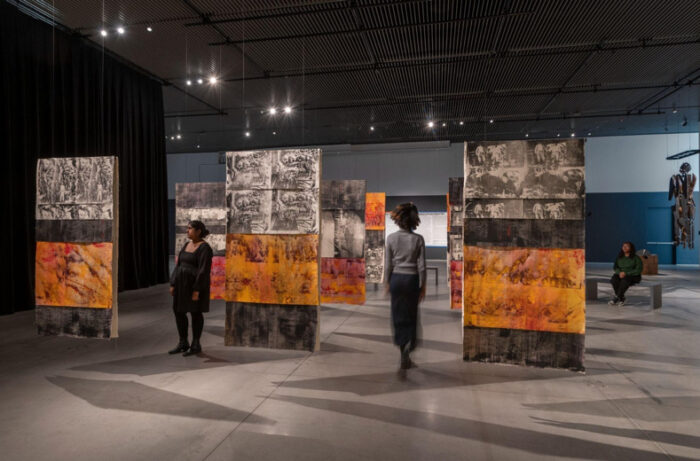
The eleven selected artists from different boroughs contemplate their communal and private memories as the isolated, the migrant, and part of a collective. Watching Cathy Linh Che and Christopher Radcliff’s Appocalips (2023) transported me to the ocean as if I were riding a boat, afloat and nostalgic for someone else’s past. The three-channel video installation is based on the real-life experiences of Che’s parents, Vietnam War refugees who fled to the Philippines by boat. After moving to the U.S., Che’s mom was hired by a sewing factory, stitching together a better future for her family. Luis A. Gutierrez’s Las Nueve Demandas (The Nine Demands) presents intricate social fabrics in suspension, visualizing the invisibility of labor injustice. Overlaying orange and black canvases, Gutierrez simultaneously displays and disguises the archival images of labor rights movement victims in Ciénaga, Colombia. Mediated with utmost love and solemnity, contemporary and distant memories collapse into each other as tautologies.
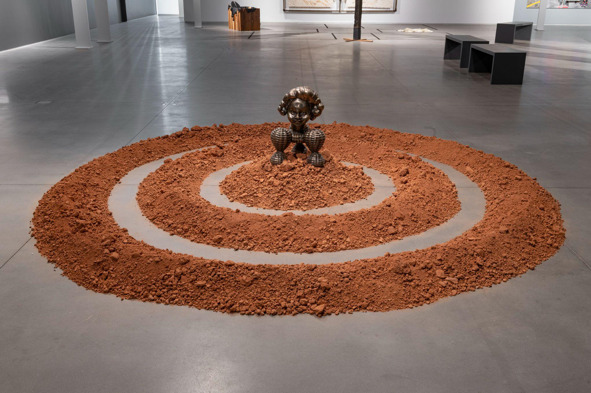
After experiencing waves of histories with intensity and gentleness, Minne Atairu’s floor-bound installation To the Hand (2023) grounded me in the land with earthly cues. Atairu surrounds her centerpiece, a 3D-printed Benin Bronze portrait head, with circles of soil in a form reminiscent of Robert Smithson’s land art Spiral Jetty. However, the soil’s close-loopness suggests they reference the rings of walls and earthworks that once guarded Benin to provide symbolic protection from colonial exploitation. Here, soil and bronze narrate the distant yet imminent desire to reclaim the lost. A similar vivification of the lost, or not-yet-lost, connected me to Bryan Fernandez’s mixed-media assemblage work Who am I, Quiénes Somos (2023). Fernandez incorporates a variety of materials, including metallic foil, cardboard, denim, shoelaces, and cargo shirts, into his authentic representation of the Dominican diaspora across the Northeast United States and the Dominican Republic. Reclaiming diasporic identity through objects, Fernandez invigorates the disembodied fragments with the viewer’s curious gaze.
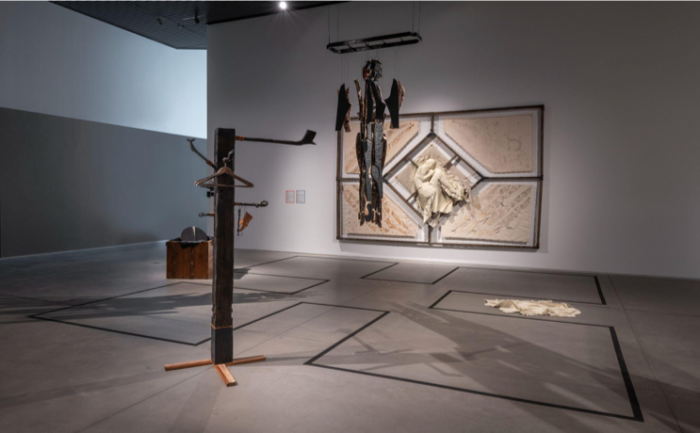
Objects detached from the body become intimate portraits of a private and public self, sustaining one’s ties with their land and identity. From lambskin and cotton to metal chains and rice, from resin and silk to pine and horsehair canvas, Calli Roche’s Death to Dermis: Ecdysis (2023) is a five-part installation that adopts a fabric of excessivity with self-perpetuating restraint. Embossed leather faces emerge through layers of cut leather with fragility and sorrow, just like death masks holding onto nothing but human evanescence. Leathered bodies are presented as either wall tapestry, rug, suspended mobile, or in a planter box, serving as the metaphor for peeling back the layers of bodies in search of one’s core. However, I kept thinking: what is the core of life but the unknowability of an ever-evolving self? The mysticality of oneself is at its most monumental form in Jeffrey Meris’s Catch a Stick of Fire III (Dark Man X), an exuberant chandelier draping LED lights below and with orchid branches as its extending arms. Referencing the artist’s weekly self-care ritual of gardening, Meris envelopes their psychological sanctuary against anti-Blackness, xenophobia, and queerphobia into intricate metalworks.
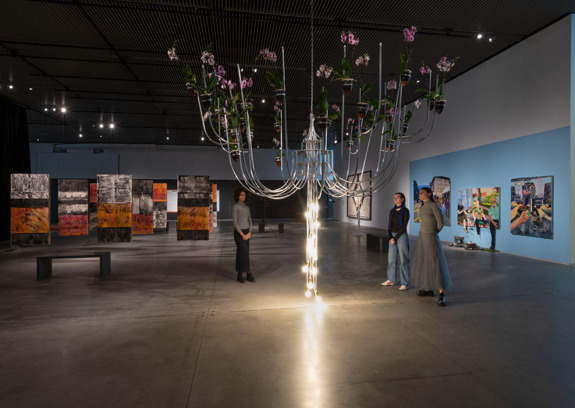
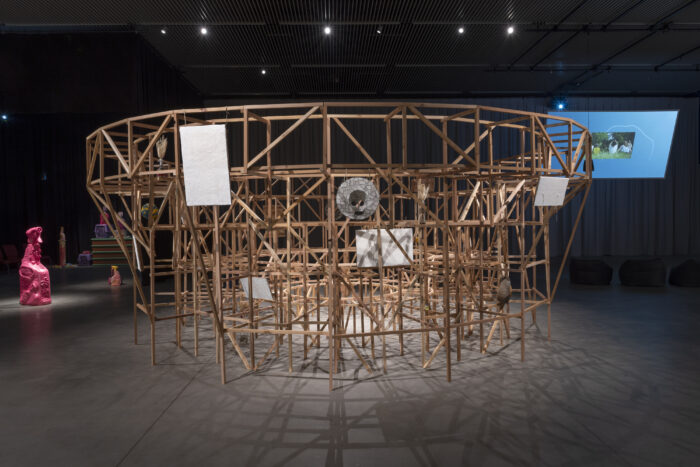
Armando Guadalupe Cortés’s Palenque (2023) is another work of monumental scale. The artist recreates a palenque, a round arena for cockfighting while revealing the bare skeleton of the under-workings of its seating arena. The intricate and see-through structure feels almost weightless, affording the viewers a treasure-hunting experience to look for the fragments placed in between spatial layers. The violence of cockfighting echoes the chaotic disillusionment portrayed in Jake Brush’s Petpourri (2023), where the artist fuses the grotesque, the frantic, and the visceral in their hallucinogenic cinematographic recasting of a story about a pet store owner craving for media attention.

My multilayered discovery of memories and histories ends with conceptual simplicity. In a self-reflexive gesture, Lizania Cruz’s Evidence 071: Frederick Douglass and The Commission of Inquiry (2023) investigates the ways in which an inquiry is performed. Sandy Williams IV’s 40 ACRES: Weeksville (2023) stages a skywriting performance tracing the border of the historic neighborhood of Weeksville, now in Brooklyn, New York. The weightlessness of clouds and the ephemerality of writing with the sky become enfolded with the conceptual weight of Williams’s larger project, 40 ACRES Archive, connecting current national inequalities to the failures of Reconstruction that followed the US Civil War.
With water, earth, and sky as the shared canvas, layers of realities are represented in a never-ending fold, enduring the inside and out of temporalities and memories in suspension and flux. Poetic and fleeting, eleven NYC artists intersect their personal perspectives with global resonances, synchronizing multiple narratives with care and compassion. Folding and unfolding individual and collective pasts, The Shed’s Open Call 2023 Group Exhibition invites a good listener to different ongoing stories.
